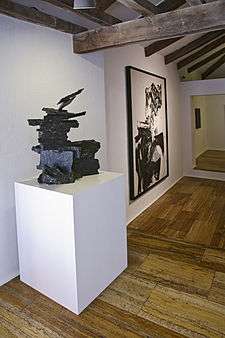Museo de Arte Abstracto Español
Coordinates: 40°04′41″N 2°07′43″W / 40.078006°N 2.128694°W


The Museo de Arte Abstracto Español (Museum of Spanish Abstract Art) is a museum in Cuenca, Spain established in 1966. It has a collection of some 129 paintings, mainly by 1950s and 1960s Spanish artists.[1]
History
In 1961 artist Fernando Zobel began looking for a suitable location for a museum of abstract art, and in June 1963 his friend, the artist Gustavo Torner, suggested the Hanging Houses of Cuenca as an appropriate site. The building is owned by the City of Cuenca, which rented it for a symbolic amount. Restoration and renovation of the building was necessary, and was carried out by local architects Fernando Barja and Francisco Leon Meler. The Museum of Spanish Abstract Art opened on July 1, 1966, with Gerardo Rueda as curator and Zobel and Torner as co-chairmen.
The core of the new museum's collection were a dozen sculptures and a hundred paintings which Zoebel had previous collected, something less than half of which were initially exhibited, with the intent of rotating the permanent exhibition. With a focus on quality rather than quantity, and not attempting to host an exhaustive survey of Spanish abstract art, the Museum does not encourage gifts of works they would not otherwise have chosen.
In 1978, the museum expanded under the direction of architect Barja, reopening on November 28 of that year.
Two years later, in 1980, Zobel donated the museums collection to the Fundación Juan March, which added it to its own collection, and took over the management and finances of the museum. That same year, the museum received the Gold Medal for Merit in Fine Arts from the Spanish Ministry of Culture.[2] It also received the European Museum of the Year Awar, given by the European Council in 1981, Castilla-La Mancha's Medal of Honor in 1991 and its "Tourism" Award in 1997.[3]
Further physical improvements in 1994 provided a special room for temporary exhibitions, and the museum continued to expand its collection – including the donation by Zobel of over 3,000 specialized books. It now has 1,500 works in its collections, of which 515 are painting or sculptures. An average of 40,000 people visit the museum each year.
Artists in the permanent collection
|
|
|
References
Notes
- ↑ "Museo de Arte Abstracto Español". March.es. Retrieved 3 January 2013.
- ↑ "REAL DECRETO 507/1980, de 7 de marzo, por el que se concede la Medalla al Mérito en las Bellas Artes, en su categoría de Oro, al Museo de Arte Abstracto de Cuenca" (PDF). March 3, 1980. Retrieved 2013-03-02.
- ↑ "Museuo de Arte Abstracto Espanol" on the Fundación Juan March website
External links
 Media related to Museo de Arte Abstracto Español at Wikimedia Commons
Media related to Museo de Arte Abstracto Español at Wikimedia Commons